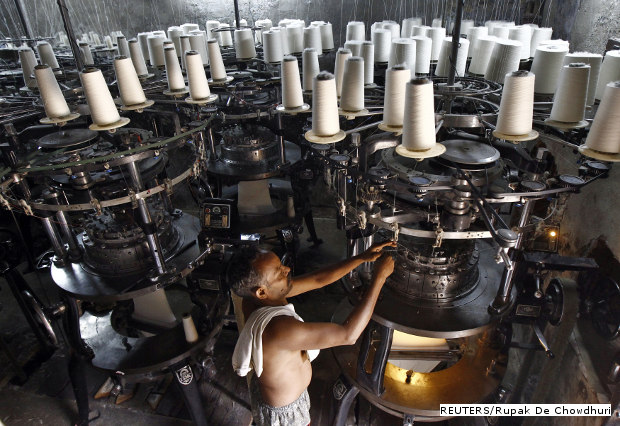Pushing For Make in India

Finance Minister Arun Jaitley has outlined policy measures for the “Make in India” plan launched by Prime Minister Narendra Modi while presenting the budget for financial year 2015-16.
The plan aims to increase manufacturing sector growth to 12-14% per annum over the medium term and create around 100 million jobs by 2022. The plan has identified 25 main sectors including IT, auto, defence and food processing sectors.
Presenting Budget 2015-16, Jaitley announced the following measures:
Tax benefits
- Tax “pass through” to be allowed to both category I and category II alternative investment funds (like hedge funds).
- Rationalisation of capital gains regime for sponsors exiting at the time of listing of the units of REITs (real estate investment trusts which mainly focus on funding realestate projects like malls and business parks).
- Rate of Income tax on royalty and fees for technical services reduced from 25% to 10% to facilitate technology inflow.
- Benefit of deduction for employment of new regular workmen to all business entities and eligibility threshold reduced.
- Basic custom duty on certain inputs, raw materials, intermediates and components in 22 items reduced to minimise the impact of duty inversion.
- All goods, except populated printed circuit boards for use in manufacture of ITA bound items, exempted from SAD (special additional duty of customs).
- SAD reduced on import of certain inputs and raw materials.
- Excise duty on chassis for ambulance reduced from 24% to 12.5%.
The thrust of “Make in India” plan is to provide tax benefits especially to overseas investors or companies. For example, General Anti Avoidance Rule (GAAR), applicable to companies that have offshore money in tax-havens like the Mauritius, has been deferred for another two years.
- Skill India initiatives will be launched to create skilled labour force. The scheme will see launch of IITs, AIIMS, a post graduate institute of horticulture research & education , three new National Institute of Pharmaceuticals Education and Research in Maharashtra, Rajasthan & Chhattisgarh and one institute of Science and Education Research in Nagaland & Orissa.
- A project development company to facilitate setting up manufacturing hubs in CMLV countries, namely, Cambodia, Myanmar, Laos and Vietnam
- Micro Units Development Refinance Agency (MUDRA) Bank, with a corpus of Rs 20,000 crore and credit guarantee corpus of Rs 3,000 crore to be created.
- Ahmedabad-Dhaulera Investment region and Shendra-Bidkin Industrial Park, part of the Delhi-Mumbai Industrial Corridor (DMIC), are now in a position to start work on basic infrastructure.
- Self-Employment and Talent Utilization (SETU) to be established as techno-financial, incubation and facilitation programme to support all aspects of start-up business. Rs 1,000 crore will be set aside as initial amount in NITI.
Incentives
- Additional investment allowance of 15% and additional depreciation of 35% to new manufacturing units set up during the period 01-04-2015 to 31-03-2020 in notified backward areas of Andhra Pradesh and Telangana.
- Made in India and the Buy and the make in India policy to achieve greater self-sufficiency in the area of defence equipment including air-craft.
The economic survey had highlighted the fact that the growth rate for industry has actually improved over the years, especially after the change in the base year from 2004-05 to 2011-12. However, the sector is still plagued by slowdown in credit growth (with the exception of mining) and corporate sector performance (with slower sales and falling net profits).
| Industrial Performance, 2012-13 to 2014-15 | |||
|---|---|---|---|
| 2012-13 | 2013-14 | 2014-15 | |
| General | 1.1 | -0.1 | 2.1 |
| Sectoral | |||
| Mining | -2.3 | -0.6 | 1.7 |
| Manufacturing | 1.3 | -0.8 | 1.2 |
| Electricity | 4 | 6.1 | 10 |
| Use based | |||
| Basic goods | 2.5 | 2.1 | 6.9 |
| Capital goods | -6 | -3.6 | 4.8 |
| Intermediate goods | 1.6 | 3.1 | 1.7 |
| Consumer goods | 2.4 | -2.8 | -4.9 |
| Consumer durables | 2 | 2.8 | -15.2 |
| Consumer non-durables | -12.2 | 4.8 | 2.2 |
Source: Economic Survey (includes percentages from April to Dec 2014-15*)
The overall growth rate has improved to 2.1% in the current financial year from a negative 0.1% last year. Basic goods (including metals, chemicals, forest products) have seen have the highest growth rate in 2014-15 at 6.9% followed by capital goods at 4.8%. Consumer durables have shown a decline of 15.2%.
___________________________________________________________________________
“Liked this story? Indiaspend.org is a non-profit, and we depend on readers like you to drive our public-interest journalism efforts. Donate Rs 500; Rs 1,000, Rs 2,000.”


